The Main Line: More than Mansions
From the Lenape to the railroads to Suburban Square
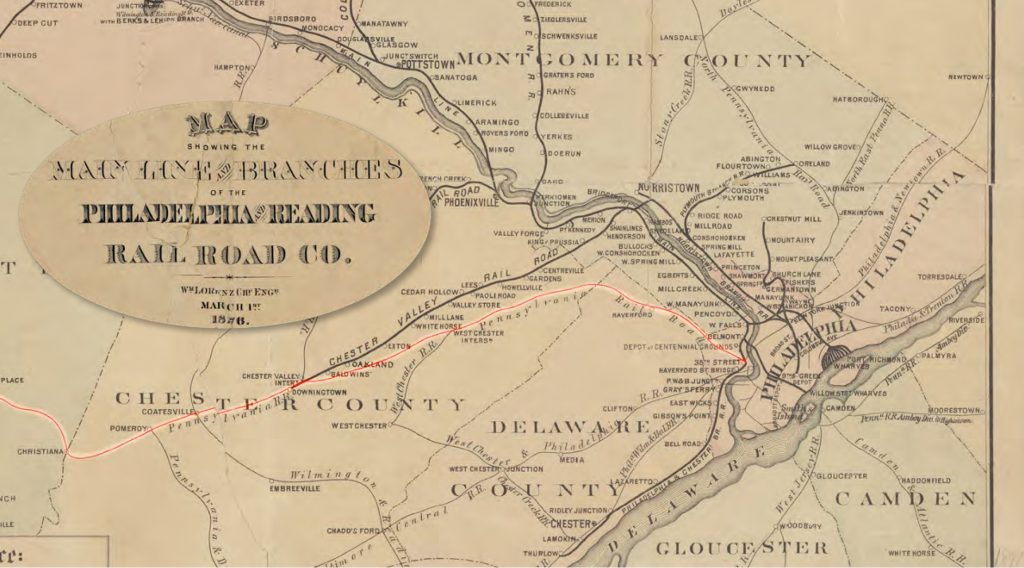 Those with a deep knowledge of local history may know that Philadelphia’s Main Line was originally inhabited by the Lenape tribe, considered by William Penn to be its true owners. Penn paid the tribe for the land in 1683, although King Charles II had chartered it to Penn two years earlier.
Those with a deep knowledge of local history may know that Philadelphia’s Main Line was originally inhabited by the Lenape tribe, considered by William Penn to be its true owners. Penn paid the tribe for the land in 1683, although King Charles II had chartered it to Penn two years earlier.
Shortly afterward, Penn sold the land — a region full of hills, forests and streams — to several Quaker families. Over time, small towns emerged. One, named Humphreysville, eventually became Bryn Mawr, Welsh for “great hill.” Today, Bryn Mawr is often regarded as the heart of the Main Line.
The area continued to develop — hosting more towns with Welsh names like Narberth, Radnor, Berwyn — becoming “the Main Line” in the 1830s, when the Pennsylvania Railroad laid its track from Philadelphia to Lancaster. Although the Main Line is noted for its extravagant mansions — see “Found Mansions on the Main Line” in the May 2021 issue of County Lines (another version in July 2024)— there are notable historic religious, educational and commercial buildings in the area a well.
Religious Buildings
There are still several religious buildings standing from the beginning of the 18th century.

For example, the Merion Friends Meeting House (653 Montgomery Ave., Merion) has been in continuous use since 1715. The Welshmen who made up the Merion Meeting contributed labor, materials, loads of stone and wood to build the meeting house. Largely unaltered today, it’s the most photographed meeting house in America. In 1998, it was named a National Landmark by the U. S. Department of the Interior.
The Radnor Meeting House (610 Conestoga Rd., Villanova), according to an inscription on its gable, was erected in 1718, but the site was used as early as 1693 for a wedding. Later, during the Revolutionary War, it served as an officers’ house and a hospital for the Valley Forge encampment. The meeting house is still in use, conducting meetings online and in person. It was added to the National Register of Historic Places (NRHP) in 1978.
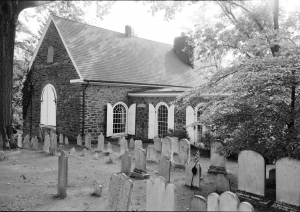
Made of logs, the original St. David’s Episcopal Church (763 S. Valley Forge Rd., Wayne) was founded in 1700, replaced by a stone church in 1715. Today, it consists of a chapel, church offices, a school and cemetery. The church had a notable role in the Revolutionary War, providing shelter for both British and Continental soldiers. Sixteen British soldiers are buried in its cemetery, which was later immortalized in a poem by Henry Wadsworth Longfellow. The original church and cemetery were placed on the NRHP in 1978.
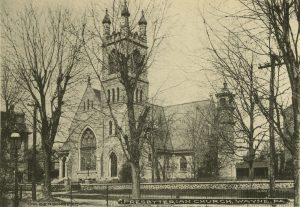
Founded in 1870 and still active, the Wayne Presbyterian Church (125 E. Lancaster Ave., Wayne), designed by John Fraser, is an inspiring stone structure, crowned with a 108-foot steeple. In 1893, the growing congregation prompted the construction of the new sanctuary. Since then, the church continued to grow, adding an education wing in 1939 and a three-story building in the 1960s.
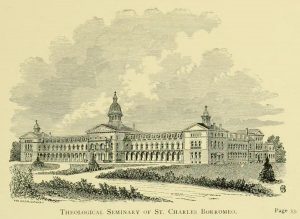
Saint Charles Borromeo Seminary (City Line Ave. & Lancaster Pk., Wynnewood) was the oldest Catholic institution of higher learning in both the Archdiocese of Philadelphia and Pennsylvania. Designed by Addison Hutton and Samuel Sloan in Spanish style with golden stucco, earth-tone brick detailing and soft arches, the seminary opened to 128 students in 1871 — by the 1960s, it accommodated nearly 600 seminarians — and closed in 2024. Sold to Main Line Health, the seminary is now closed to the public. It was added to the NRHP in 1979.
Schools, Colleges and Universities
Offering free education to all, the Lower Merion Academy (501 Bryn Mawr Ave., Bala Cynwyd) was first named the Lower Merion Benevolent School when it opened 1812. It was added to the NRHP in 2002. By the early 20th century, the federal-style stucco stone building had become too small for the growing community, so lower and middle public schools were built nearby. It’s the oldest school building in Montgomery County and currently houses the Lower Merion Historical Society.
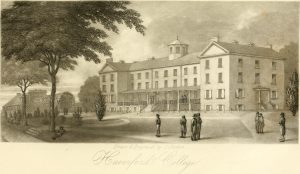
Since Haverford College’s founding, the centerpiece of its campus has been Founders Hall (370 Lancaster Ave., Haverford). It’s eligible, but not on, the NRHP as part of the Haverford College campus historic district. Completed in 1834, the building originally served the entire operations of the college. Over the years, with additions, it’s been used as a student and faculty dormitory, dining hall, library and other purposes and is the location of Haverfest, an annual two-day end-of-year party.
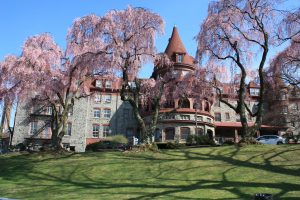
Originally called College Hall, the east wing of Alumni Hall (800 E. Lancaster Ave., Villanova) is the oldest structure on the Villanova University campus, dating to 1848, and listed on the NRHP. Over the years, Alumni Hall has contained classrooms, offices, library, auditorium and dormitories. Now used as a dormitory, it houses about 110 students.
Designed by Addison Hutton in 1884 in Victorian-Gothic style, Taylor Hall (101 N. Merion Ave., Bryn Mawr), is the original administrative and academic building of Bryn Mawr College. As part of the College’s Historic District, it’s listed on the NRHP and currently contains offices and classrooms.

The Baldwin School (701 Montgomery Ave., Bryn Mawr) is an independent school for girls, originally to prepare them to enter Bryn Mawr College. It’s housed in the former Bryn Mawr Hotel, previously called the Keystone Hotel. In 1896, the school leased the hotel and, in 1922, bought it. Built in 1892 and designed by Frank Furness in chateau style, it was placed on the NRHP in 1979.
Rathalla (1400 Montgomery Ave., Bryn Mawr) is the main building of Rosemont College. The stone building, designed by Edward Hazelhurst and Samuel Huckel and completed in 1891, was originally the home of Joseph Sinnott. It was sold to the Society of the Holy Child of Jesus in 1921 and in 1927 for $1 to Rosemont College. It was added to the NRHP in 1980.
Turnpikes and Railroads
In 1741, the Pennsylvania colony built the Great Conestoga Road, connecting Philadelphia with Lancaster. Use of the road, however, lapsed. Not until 1794 was a graded gravel private toll road opened connecting the two cities. The next connection between Philadelphia and Lancaster was in 1834, when the Philadelphia and Columbia Railroad finished an 84-mile stretch of tracks. Eventually, in 1857, the P&C Railroad was purchased by the Pennsylvania Railroad and became part of a system that reached Pittsburgh.
The railroad, of course, needed stations. In 1863, the Philadelphia architectural firm, the Wilson Brothers, designed the Bryn Mawr Train Station (54 N. Bryn Mawr Ave., Bryn Mawr), listed on the NRHP in 1979. The largest and busiest of the Main Line stations, the Victorian-style building was demolished in 1969. Only the freight and baggage building — now The Pullman Restaurant and Bar — remains.
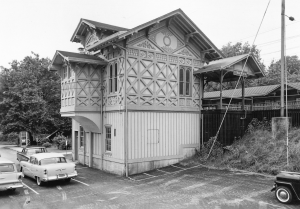
What’s now the Strafford Railroad Station (97 Old Eagle School Rd., Wayne) was originally the Japanese Pavilion in the 1876 Fairmount Park Centennial Exposition. After the event, the building was purchased by the railroad and moved to Louella (Wayne), where it was used as a station for two years. In 1887, the two-story building was moved to Eagle (renamed Strafford). It was added to the NRHP in 1984.
Sport, Recreation and Socialization
The first Devon Horse Show, held in 1896, took place at the Devon Race Track and Polo Grounds, now called the Devon Horse Show Grounds (23 Dorset Rd., Devon). It was then a one-day event but has since evolved (see the article in this issue). In 1914, a grandstand was erected, and comfortable box seats were installed. By the 1920s, stalls were built, first for William du Pont, then for others. Today the Devon Horse Show and Country Fair has become the largest outdoor multi-breed horse show in the country.
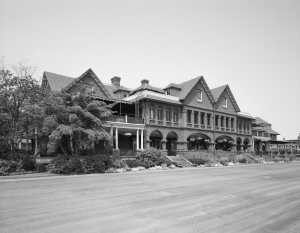
Designed by Frank Furness and built in 1896, the Merion Cricket Club (325 Montgomery Ave., Haverford), a National Historic Landmark since 1987, was once described as “the most complete and largest country-club house in this country.” Its history covers cricket, lawn tennis, platform tennis, bowling, golf, soccer, squash, racquets, field hockey and badminton, and it remains a sports and community hub.
Since 1924, the Merion Tribute House (625 Hazelhurst Ave., Merion Station), designed by Livingstone Smith and Walter Karcher using local stone and Gothic features, has hosted weddings, social gatherings and corporate events. Eldridge Johnson, founder of the Victor Talking Machine Company and popularizer of the Victrola, offered his property as a tribute to local men who served during World War I. He asked that it be “the most beautiful structure of its kind in this locality.”
Health and Shopping

Bryn Mawr Hospital (130 S. Bryn Mawr Ave., Bryn Mawr) was founded in 1893 and designed by Frank Furness in a style known as Furness Classic. Initially, it had a capacity for just 20 patients, with only three physicians on staff. Now a 264-bed acute care hospital, it’s known for outstanding patient care and a history of medical advancements. Its Gerhard Building is eligible for listing on the NRHP.
Established in 1928, Suburban Square (Anderson & Coulter Aves. Ardmore) is one of the country’s first outdoor shopping centers. The eight-story former Strawbridge & Clothier building was designed by the firm of Dreher and Churchman and is credited as the first true suburban department store. In 1930 — and still — the building dominates those around it. It became a Macy’s in 2006 and, in 2017, was replaced by a health club and furniture retailer.
The Main Line has come a long way since the Lenape struck their deal with Billy Penn and the first settlers began to till its soil. Farms gave way to meeting houses then churches. Rough paths gave way to turnpikes then railroads and paved streets. Modest cabins became mansions. Schools, recreation, hospitals and retailing became big business. In the 21st century, however, we can still find its roots in its 300-plus years of buildings.
